Articles
Japan-South Korea relations are going strong. In the months leading up to the historic Camp David trilateral summit in August, we saw the return of shuttle diplomacy between Korea and Japan. If President Yoon Suk Yeol’s March visit to Japan was groundbreaking, Prime Minister Kishida Fumio’s May visit to Seoul signified the continued momentum of improving bilateral ties. The Aug. 18 trilateral summit meeting, where President Biden, President Yoon, and Prime Minister Kishida announced bold steps to cement trilateral cooperation into the institutional fabric of the relationship, represents the deepest attempt in recent memory. A successful trilateral summit like this one was possible only because Seoul and Tokyo mended their bilateral ties. A positive cycle is expected the other way around, as well. For example, the “Commitment to Consult” —to expeditiously “share information, align messaging and coordinate response actions” among the three leaders—will likely create more incentives and opportunities for Seoul and Tokyo to keep bilateral relations friendly and cooperative.
As Seoul, Tokyo, and Washington took the biggest leap toward the goal of institutionalized trilateral cooperation, the big question is how sustainable it will be. The 78th Liberation Day speech by President Yoon, while signaling a helpful tone of goodwill with Japan, raised some concern as there was hardly any mention of history.
Shuttle Diplomacy is Back
On May 7-8, Japanese Prime Minister Kishida Fumio reciprocated President Yoon’s March visit to Japan by visiting South Korea. His visit was the first by a Japanese leader since 2018, and marked the return of shuttle diplomacy after 12 years. There were two noticeable deliverables from the summit. One was the agreement that South Korea would send an inspection team of Korean experts to check the on-site water at the Fukushima nuclear reactor. The second was Kishida’s invitation for Yoon to attend the G7 summit in Hiroshima from May 19-21. Both leaders acknowledged how quickly bilateral ties have improved since their last summit, alluding to how the “grave” security environment they both face makes bilateral cooperation “essential.”
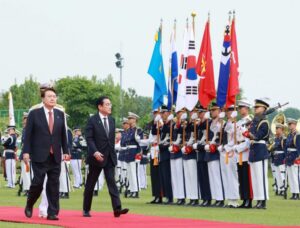
Figure 1 Prime Minister Kishida and South Korean President Yoon Suk Yeol (left) at a welcome event at the presidential office in Seoul on May 7. Photo: Pool photo/co-published
On the forced labor plan, President Yoon emphasized once again the plan is the only viable solution that satisfies both the 1965 Basic Treaty and the 2018 Supreme Court ruling. His solution has had a political cost for Yoon—his approval rating had dropped to 30% and nearly 60% of South Koreans opposed his plan. But it is worth noting that 10 out of 15 plaintiffs in the forced labor suit have been compensated by the South Korean government’s established foundation. And in the week prior to the May summit meeting with Japan, one of the three surviving forced labor victims expressed intent to accept the reimbursement, leaving four plaintiffs left. For Prime Minister Kishida, there were talks leading up to the summit of a desire by the Korean public for some sort of “reciprocal action” from him. During a joint press conference with Yoon, he offered his own personal feelings and said his “heart hurts” for the “difficult and sad experiences” of the Korean forced laborers. While not the official apology most Koreans wanted, Kishida’s unscripted remarks were a compromise.
President Yoon’s three-day visit to Hiroshima marked the third time the two leaders have met in two months. During this trip, Yoon and Kishida paid a symbolic joint visit to the cenotaph for Korean victims of the 1945 atomic bombing at the Hiroshima Peace Memorial Park, a first for the leaders of both countries. They also held a trilateral summit with President Biden on the sidelines of the G7, where they continued discussions on how to bring cooperation to a “new level” and “new heights.” At the meeting, Biden invited them to a formal trilateral summit in the US, which became the Camp David summit.
Amid this positive reciprocity, the defense ministers of Japan and South Korea, Hamada Yasukazu and Lee Jong-sup, agreed in early June to find ways to prevent future disputes like the radar lock-on incident that took place in December 2018. This meeting marked their first bilateral defense ministerial talks in over three years. Hamada and Lee strongly criticized North Korea’s satellite launch on May 31, which violated UN Security Council resolutions that prohibit Pyongyang from conducting any launch that uses ballistic missile technology. Since the Yoon and Kishida administrations began their rapprochement a year ago, their lockstep responses to North Korea’s provocations served as a common denominator. So far in 2023, the US, South Korea, and Japan have participated in trilateral anti-submarine warfare exercises, anti-submarine and search-and-rescue exercises, and missile defense exercises. They continued to respond to North Korea’s missile tests with a trilateral joint missile defense exercise in July—the fourth since May 2022—and a maritime ballistic missile defense warning test in mid-August. They are also resuming trilateral maritime interdiction and anti-piracy exercises.
The Camp David Trilateral Summit
At Camp David, President Biden began the joint press conference by saying, “if I seem like I’m happy, it’s because I am.” This trilateral summit was the kind that the US government across both Democratic and Republican administrations has been pursuing as an enabler of US Asia strategy. On the sidelines of the summit, Kishida and Yoon held their 7th summit meeting. From the perspective of Seoul-Tokyo relations, the Camp David meeting was historic at least for five reasons.
First, this summit was an unmistakable expression that South Korea under the Yoon administration will actively participate in shaping the future of regional and international order. In a remarkable, if not surprising, contrast to the previous Moon administration, Yoon made it very clear that South Korea sees its future hinging on its working relationship with Japan and the United States. In this trilateral frame, the significance of Japan is visibly enhanced in South Korean foreign policy. In the Spirit of Camp David, they committed to coordinating responses to “challenges, provocations, and threats” to their collective security and interests. Japan’s major liberal daily Asahi Shimbun commented how the trilateral summit was a “historic step” for South Korea. An editorial in Yomiuri Shimbun, a major conservative daily, attributed the improved relations between Japan and South Korea to President Yoon’s position of regarding Tokyo as a “partner that shares values.”
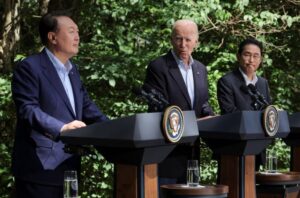
Figure 2 US President Joe Biden holds a joint press conference with Japanese Prime Minister Kishida Fumio and South Korean President Yoon Suk Yeol during the trilateral summit at Camp David near Thurmont, MD, Aug. 18, 2023. Photo: Reuters/Jim Bourg
Second, the trilateral summit suggests a real potential for Seoul and Tokyo to be like-minded partners beyond consultations over North Korea, seeking to shape the contours of international affairs in the Indo-Pacific. A set of shared common principles captured in the so-called Camp David Principles include a “bedrock of shared values, mutual respect, and a unified commitment to advance prosperity.” Specifically, these principles include a free and open Indo-Pacific, the complete denuclearization of North Korea, human rights in North Korea, peace and stability across the Taiwan Strait, as well as technology, climate change, development and humanitarian response cooperation, and much more.
Third, the three partners took huge strides toward institutionalizing and strengthening security cooperation to a point where observers wonder if this summit will be remembered as the beginning of a trilateral alliance. They regularized military exercises with a multi-year trilateral exercise plan to include an “annual, named, multi-domain trilateral exercises on a regular basis.” This outcome is a step beyond the ad-hoc exercises they have held in response to North Korean actions this past year. They outlined their intent to operationalize the sharing of North Korean missile warning data by the end of the year. They established a new trilateral Working Group on North Korean cyber activities. And lastly, they agreed to enhance information sharing and coordination through a 2014 trilateral arrangement and their bilateral General Security of Military Information Agreements (GSOMIA).
Fourth, they released an ambitious schedule of trilateral dialogues to facilitate regular communications at the highest levels. This demonstrates that they seek to put in place the idea that they “stand as one” in Camp David Principles. These include annual meetings of the leaders, foreign ministers, defense ministers, and national security advisors, as well as new annual meetings of the finance, industry and commerce ministers. They also launched a new Trilateral Indo-Pacific Dialogue, on top of the trilateral economic security dialogue launched earlier this February and the trilateral development policy dialogue planned for October. By having a regular schedule of meetings (unlike one-offs on the sidelines of the G7 or NATO), this ensures that cooperation is constant, coordinated, and timely throughout the year.
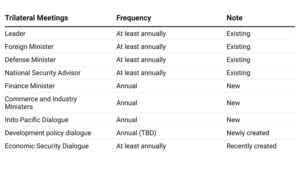
Table 1. Schedule of Trilateral Dialogues. “The Spirit of Camp David,” Credit: The White House
Finally, one of the most notable developments is cooperation on economic security issues, including their joint step toward a Supply Chain Early Warning System Pilot. Japan, South Korea, and the United States share the goal of preventing global supply chain disruptions. This signifies the expansion of areas of cooperation beyond traditional security issues, and not only in the Indo-Pacific but also globally. In conjunction with the Biden administration’s “friend-shoring” strategy of reshoring essential materials, goods, and services with only like-minded democratic countries and allies, Seoul and Tokyo have sought to expand coordination with Washington. Under “the Spirit of Camp David” joint statement, they agreed to broaden cooperation on economic security, supply chain resilience, countering misinformation, development assistance, clean energy, critical minerals, pharmaceuticals and emerging technologies such as biotechnology, artificial intelligence, quantum computing and space. They also created mechanisms such as a new dialogue on disruptive technology protection measures, a trilateral technology leaders training program, and more collaboration among the three National Laboratories.
The trilateral summit was popular among the Japanese public. According to the Yomiuri Shimbun public opinion poll in late August, 60% of Japanese respondents said that they supported Kishida’s trilateral summit, even while his overall Cabinet approval rating remained unchanged at 35% from July. In South Korea, while the ruling People Power Party evaluated that the outcomes of trilateral summit should be given an A+ grade, the opposition Democratic Party expressed concerns that Korea will become a focal point of the new Cold War politics. President Yoon’s overall public approval rating slightly went up 2% to 37.6%, due to the generally positive public assessment of the trilateral summit.
Fukushima Wastewater Release
The Japanese government’s Fukushima wastewater release could have derailed Seoul-Tokyo relations. This issue presented President Yoon with a dilemma and a political risk, making him vulnerable to opposition party criticism that his Japan policy was too accommodating to Japan’s national interests over South Korea’s. On Aug. 24, Japan began discharging the first tranche of more than a million tons of ALPS-treated wastewater from the Fukushima Daiichi into the Pacific Ocean. This first release of about 7,800 tons of wastewater will last for about 17 days. The planned discharge will likely take three decades as there are more than 350 million gallons of the radioactive water, stored in more than 1,000 tanks. Since they announced the plan two years ago, the Japanese government and the Tokyo Electric Power Company, which operates the nuclear powerplant, have repeatedly promised the treated water is safe—despite a finite amount of radioactive tritium—and that their plan was the best course of action (they had assessed five options).
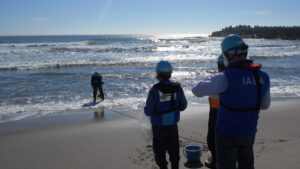
Figure 3 IAEA staff sampling seawater from the coast near the Fukushima Daiichi Nuclear Power Station as part of the Agency’s safety review of the ALPS treated water discharge. TEPCO
To bolster transparency and accountability, Tokyo requested the International Atomic Energy Agency (IAEA) to conduct an independent safety review of the plan. The IAEA findings were released in July 2023, which concluded that Japan’s plan is 1) consistent with international safety standards, and 2) the “controlled, gradual discharges of the treated water to the sea” would have a “negligible radiological impact on people and the environment.” Furthermore, the IAEA promised to continue its independent safety review of the discharge plan, which includes having a continuous on-site presence and a live monitoring website.
Despite its effort for reassurance using scientific backing and technical regulatory standards, Japan faced strong public backlash at home and from neighboring countries. At home, Prime Minister Kishida has pledged his full support for the fishing industry and the reputational damage throughout the water discharge process. His government has offered about $550 million in aid to fisherman and for sales promotion. In the aftermath of China’s seafood ban, the government announced it is putting together another package to help those affected. The Japanese public was more concerned about the reputational damage to Japanese seafood, with 75% of Japanese voters calling the Kishida government’s efforts insufficient. In the same survey, 53% said they supported the water discharge plan, with 41% saying they disapproved. By early September, a poll by the Social Survey Research Center suggests that nationwide responses within Japan showed a higher level of acceptance of the government decision.
In South Korea, the official government position is that they have no scientific or technical issues with Japan’s plan, but it neither approves nor opposes the plan. The issue became one that everyday South Koreans, even those who support strong ties with Japan, feel nervous about. Surveys of the South Korean public showed that more than 80% opposed the water discharge plan. A Gallup Korea poll found that 70% of Koreans were concerned about its impact on seafood, with 60% worried about eating seafood. The poll noted that “half of those who identify as conservative” had expressed concern about the issue. Another poll the same week had 92.4% of respondents saying they will reduce their seafood consumption.
The ruling People Power Party has emphasized the scientific backing to assuage public concern. The government announced the establishment of a hot line with the IAEA and the Japanese government for effective communication of South Korean views that may arise in the process of monitoring. As part of their efforts to reduce concerns over local seafood, the Yoon administration expanded radiation tests on seafood in fish markets, and even started testing sand in its beaches. President Yoon also publicly ate seafood from the Noryangjin fish market in Seoul to show that the seafood is safe. At the end of August, the Yoon government announced a $104 million package to boost local seafood consumption, which includes subsidies for types of fish and discount vouchers.
But in conjunction with the timing of the trilateral summit, the issue is increasingly contentious. South Korea’s environment groups have been shouting, “the sea is not Japan’s trash bin.” A day after the water discharge began, 16 South Korean protesters were arrested for entering a Japanese embassy building. That weekend, about 50,000 protesters gathered in Seoul to demand tha the Yoon government respond to Japan’s action. On Aug. 31, Lee Jae-myung, the South Korean opposition leader, began a hunger strike against Yoon’s policies, and called on Yoon to oppose Japan’s water discharge plan as one of his three demands.
Yoon’s Liberation Day Address and Looking Ahead
President Yoon’s address on the Aug. 15 Liberation Day was striking to many who are familiar with the Korean narrative that accompanies presidential Independence Day speeches. This year, there was no mention of history. Japan’s past atrocities or the Fukushima wastewater release issue were not mentioned. Instead, he spoke of “still rampant …anti-state forces [in South Korea] that blindly follow communist totalitarianism, distort public opinion, and disrupt society through manipulative propaganda.” This incurred heavy criticism from the opposition party for not being conducive to national unity. Within the ruling party, Kim Jong-in, for example, commented that Yoon’s speech generalized the very few who sympathize with communism into much larger forces.
Many South Koreans feel the strong need to work with Japan for national security and economic reasons, and thus support Yoon’s position of improving relations with Japan. But in thinking about the future of Japan-Korea relations, it is important to remember that there is no major change in South Korean public sentiment toward Japan’s past wrongdoings. Nor does there seem to be notable change in the Japanese position on bilateral historical and territorial issues. During the Camp David trilateral summit joint press conference, a reporter asked President Yoon, “how much confidence can Japan and the US have about Seoul’s long-term commitment to rapprochement when polls show the solid majority of Korea disapproves of your handling and mending of the forced labor issue?” Yoon acknowledged that “this is something that we need to continue working on.”
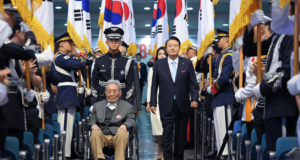
Figure 4 President Yoon Suk Yeol arrives at Ewha Womans University while accompanied by Oh Seong-gyu, a former Korean independence fighter, and first lady Kim Keon-hee to deliver his Liberation Day address, Aug. 15, 2023. ROK Presidential Office
There are general elections in South Korea next spring, presidential election in the US next fall, and Japan must hold elections before October 2025. Naysayers may be quick to point out that once the current parties in any of the three capitals leave office, these developments are easily reversible by the next administration. For a relationship long fraught by bilateral tensions over history, the leaders of Japan and South Korea seem to understand that for their partnership to last beyond their terms in office, they needed a robust set of actionable commitments and resilient institutions. Both Yoon and Kishida at the top of their respective governments, even while making a strong show of unity between them and with the United States, are have to respond to their publics and navigate domestic political turmoil. While history can repeat itself, only time will tell if the “Spirt of Camp David” can withstand the vagaries of time.
May 2, 2023: On the sidelines of the Annual Meeting of the Board of Governors of the Asian Development Bank in Incheon, South Korean and Japanese finance ministers agree to resume their annual finance meeting in the near future. At the same annual meeting, South Korea, Japan, and China hold their first trilateral meeting of finance ministers and central bank governors since 2019.
May 2, 2023: Total number of surviving comfort women registered with the South Korean government declines to nine after a comfort woman passes away.
May 3, 2023: One of the three surviving South Korean forced labor victim expresses intent to accept third-party reimbursement as part of the compensation plan reached between South Korea and Japan.
May 7, 2023: Japanese Prime Minister Kishida Fumio arrives in South Korea for the start of two-day visit and a summit with South Korean President Yoon Suk Yeol, the first visit by a Japanese leader since 2018. The two leaders agree to allow a group of South Korean experts to visit the Fukushima nuclear power plant to conduct an on-site inspection of the planned wastewater release. Kishida also offers his own personal feelings and said his “heart hurts” for the “difficult and sad experiences” of Korean forced laborers.
May 9, 2023: South Korea, the US, and Japan work on a consultation group on sharing missile warning data in real time.
May 10, 2023: South Korea’s Federation of Korean Industry (FKI) and Japan’s Keidanren launches a joint steering committee for their $1.5 million “partnership fund.”
May 12, 2023: President Yoon hosts former Japanese Prime Minister Aso Taro for dinner.
May 13, 2023: South Korea and Japan agree on a four-day visit for the South Korean delegation to assess the Fukushima wastewater discharge plan.
May 15, 2023: Prime Minister Kishida tells JoongAng Ilbo that he wants to “open a new era of friendship and trust” with South Korea.
May 21, 2023: A 21-member South Korean delegation arrives in Japan for a four-day visit to assess the Fukushima wastewater discharge plan.
May 26, 2023: South Korea’s Foundation for Victims of Forced Labor Mobilization by Imperial Japan, the foundation set up by the South Korean government to carry out the forced labor compensation plan, announces it has paid compensation for the first time to one surviving forced labor victim.
May 27, 2023: Prime Minister Kishida calls for high-level negotiations with North Korea over the abduction issue.
June 3, 2023: US Secretary of Defense Lloyd J. Austin, South Korean Defense Minister Lee Jong-sup, and Japanese Defense Minister Hamada Yasukazu hold a trilateral ministerial meeting in Singapore and issue a joint statement.
June 4, 2023: Korean DM Lee and Japanese DM Hamada meet on the sidelines of the Shangri-La Dialogue and agree to hold working-level talks to resolve and discuss ways to prevent the recurrence of the 2018 maritime dispute.
June 14, 2023: South Korea and Japan hold a ceremony to launch the joint technology R&D project to strengthen the competitiveness of their fine chemical industries.
June 15, 2023: US National Security Advisor Jake Sullivan meets with his Japanese and South Korean counterparts in Tokyo for a trilateral national security advisors meeting.
June 15, 2023: South Korean government starts daily press briefings to update the public on the planned release of treated radioactive water from the Fukushima nuclear plant.
June 19, 2023: Data from the Korea Customs Service shows that Korean imports of Japanese seafood in May decreased 30.6% compared to the previous year.
June 27, 2023: South Korea and Japan hold a video conference briefing session on the treated radioactive water from the Fukushima nuclear plant.
June 30, 2023: Korea Customs Service announces that Commissioner Yoon Tae-sik will meet his Japanese counterpart in the second half of 2023, the first such meeting since 2016.
June 30, 2023: South Korean Trade Minister Ahn Duk-geun meets with Hirohide Hirai, Japan’s vice minister for international affairs in Seoul to discuss the bilateral relationship.
July 3, 2023: Chinese Foreign Minister Wang Yi attends the 2023 International Forum for Trilateral Cooperation held in Qingdao and says China, South Korea, and Japan should “create an atmosphere for the early resumption of leaders’ meetings.”
July 4, 2023: International Atomic Energy Agency (IAEA) concludes that Japan’s planned release of treated wastewater is consistent with international safety standards.
July 7, 2023: IAEA Director General Rafael Grossi arrives in South Korea to meet Korean Foreign Minister Park Jin and Yoo Guk-hee, chairperson of South Korea’s Nuclear Safety and Security Commission, as well as representatives of the opposition Democratic Party to discuss Japan’s plans to release Fukushima wastewater.
July 7, 2023: South Korea’s Ministry of Trade, Industry and Energy and Japan’s Ministry of Economy, Trade and Industry hold Export Control Policy Dialogue and sign a Memorandum of Cooperation to periodically hold these policy dialogues.
July 10, 2023: 10 members of South Korea’s National Assembly, civic activists, and South Korean fishermen protest Japan’s planned discharge of Fukushima water outside Japanese Prime Minister Kishida Fumio’s residence in Tokyo.
July 13, 2023: Foreign Minister Yoshimasa Hayashi and South Korean Foreign Minister Park meet in Jakarta on the sidelines of ASEAN-related Foreign Ministers’ Meetings, and discuss Japan’s plan to discharge treated water as well as North Korea’s ballistic missile launch.
July 14, 2023: US Secretary of State Antony Blinken, Japanese FM Hayashi, and Korean FM Park hold a trilateral Foreign Ministers’ meeting in Jakarta and issue a Joint Statement.
July 16, 2023: Japan, South Korea, and US hold trilateral missile defense exercise in the sea between Korea and Japan.
July 20, 2023: US, South Korean, and Japanese nuclear envoys, Sung Kim, Kim Gunn, and Funakoshi Takehiro, respectively, meet in Japan to discuss North Korea’s latest missile test.
July 21, 2023: Japan returns South Korea to its white list of preferred trading partners, four years after removing it from the list.
July 24, 2023: South Korea begins radiation tests on seawater in 108 ports to check for radioactivity levels to ease concerns over the Fukushima wastewater discharge plan.
July 24, 2023: US Deputy Secretary of State Wendy Sherman, Korean Vice Foreign Minister Chang Ho-jin, and Japanese Vice Foreign Minister Takeo Mori hold call to discuss ways to expand trilateral cooperation.
July 25, 2023: South Korea’s Ministry of Oceans and Fisheries announces the radiation level of all seafood imported from Japan in 2023 is within the safe range.
July 25, 2023: South Korea and Japan hold first round of working-level meetings in Tokyo to discuss the Fukushima wastewater discharge plan.
July 27, 2023: South Korean government reassures the public that it has adopted the strictest method to test radiation levels in seafood imports from Japan.
July 28, 2023: South Korean government protests Japanese claims to Dokdo/Takeshima in its latest defense white paper.
Aug. 7, 2023: South Korea and Japan hold second round of video conference talks to discuss the Fukushima wastewater discharge plan.
Aug. 15, 2023: In his Liberation Day speech, President Yoon calls Japan and South Korea “partners that cooperate on security and the economy.”
Aug. 16, 2023: South Korea and Japan hold third and final round of video conference talks to discuss the Fukushima wastewater discharge plan.
Aug. 17, 2023: Busan District Court rejects lawsuit to stop the Fukushima wastewater discharge plan.
Aug. 18. 2023: President Biden, President Yoon, and Prime Minister Kishida hold a historic trilateral summit at Camp David, and adopt the Spirit of Camp David and the Camp David Principles.
Aug. 22, 2023: South Korean environmental groups hold protests in Seoul against Japan’s Fukushima wastewater discharge plan, scheduled for Aug. 24.
Aug. 23, 2023: IAEA and South Korean government agree to set up a regular information-sharing framework on Japan’s Fukushima wastewater discharge plan.
Aug. 23, 2023: Korean Prime Minister Han Duck-soo says the Korean government will file an international lawsuit if Japan’s wastewater discharge plan is not conducted to standards.
Aug. 24, 2023: Japan begins the release of ALPS-treated wastewater from the Fukushima Daiichi nuclear power plant into the Pacific Ocean.
Aug. 24, 2023: South Korean government says there are “no scientific or technical problems” with Japan’s wastewater discharge plan, but adds that it “neither approves nor opposes the plan.”
Aug. 24, 2023: South Korean opposition leader Lee Jae-myung calls Japan’s release of wastewater from Fukushima an “evil act” and “one of the worst environmental destructions.”
Aug. 24, 2023: Korean PM Han calls on Japan to transparently disclose information about its wastewater discharge plan at the Fukushima Daiichi nuclear powerplant for the next 30 years.
Aug. 26, 2023: Sixteen South Korean university students are arrested for attempting to enter a Japanese embassy building in Seoul in protest of the wastewater discharge plan.
Aug. 27, 2023: Four South Korean opposition party lawmakers participate in a local protest in Fukushima against the wastewater discharge plan.
Aug. 28, 2023: South Korean government announces that the amount of tritium in seawater after Japan began discharging ALPS-treated wastewater into the ocean is safe and well below the standard limit.
Aug. 28, 2023: South Korea launches a 100-day inspection into the country of origin marking for imported seafood.
Aug. 28, 2023: President Yoon and PM Han eat seafood together to show domestic seafood is safe and assuage public concerns.
Aug. 29, 2023: South Korea, Japan, and the US hold a trilateral missile defense exercise in respond to North Korea’s failed satellite test.
Aug. 31, 2023: President Yoon eats seafood in a South Korean fish market in an ongoing campaign to show the safety of domestic seafood.